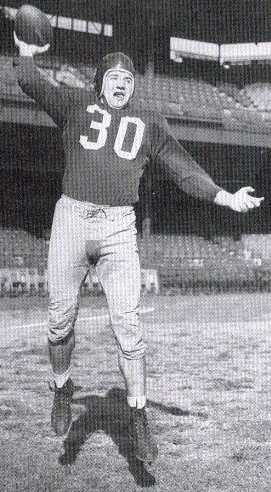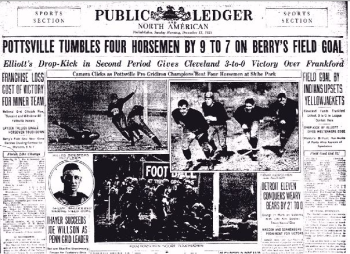Is it possible to talk about Deflategate and leave emotion — which runs high on both sides — on the inactive list? Let’s try.
As you may have noticed, a large faction of NFL Nation has been doing backflips since the league announced its ruling, which suspends Tom Brady for four games, fines the Patriots $1 million and strips them of first- and fourth-round draft picks next year. What Roger Goodell did is kind of like what Sheriff Bullock did to George Hearst, the mining mogul, in Deadwood. The commissioner didn’t just throw Brady in jail, he took him there by the ear.
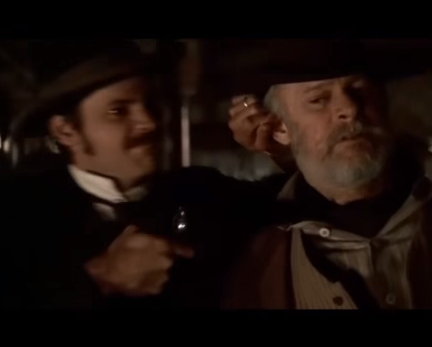
Sheriff Bullock escorts George Hearst to the hoosegow in “Deadwood.”
It isn’t hard to understand the lust for Patriots blood that rages in the other 31 NFL cities. New England hasn’t just owned the league the last 14 seasons, winning four Super Bowls, it’s done it, at times, very annoyingly. Pro football has always been a few-holds-barred enterprise, but the Pats seem to glory in testing boundaries and flouting rules — whether it’s videotaping defensive signals, fooling with the air pressure in balls or some other bit of only-whispered-about subterfuge.
I mean, we get it, fellas, we really do. For Bill Belichick, son of a longtime Navy coach, football is Total War (minus the bullets, the drones, the IEDs, the fatalities . . . did I leave anything out?). Or to put it another way: Nobody worried about whether Grant had too many men on the field at Vicksburg.
The lengths the Patriots have gone to in their pursuit of victory have diminished their considerable accomplishments. They’re on one of the great runs in NFL history, but they’ve left fans wondering — with some justification — how much of their success is due to their willingness to step over the line, to operate in the Gray Area.
Of course, pro football has always had its villains. In the early years, no one had anything on the Bears’ George Halas in the ruthlessness department. Later on, Al Davis’ Raiders were the team people loved to hate. Belichick’s Patriots are merely the latest in the line, and probably not the worst. You could get away with so much more in the days before saturation media coverage and omnipresent security cameras. Heck, the home team used to pay the officials, and some clubs played a lot more home games than others.
Nevertheless, this latest Patriots scandal seems far more overinflated than the balls were underinflated. It broke at the most visible time of the season, in the run-up to the Super Bowl, and it raged pretty much out of control until Tuesday, when Goodell meted out his punishment. The NFL tried, feebly, to contain it, but the rumors, leaks and innuendo flew — and kept on flying — until the Wells Report was finally released 108 days later. It was yet another reminder that the most powerful league on the planet seems to have forgotten how to manage crises.
But let’s move on. One of the problems with this scandal is that folks can’t agree on whether Brady was guilty of a felony, a misdemeanor or an even lesser offense — like jaywalking — for his assumed role in this circus. Maybe the gravity (or lack thereof) of the situation will become clearer if we take a trip back in time. For starters, underinflated footballs have never been much of an issue in the NFL before now. Fascinating, don’t you think? A search of various newspaper archives the other day turned up almost nothing — since 1960, at least.
There was one story, in 1973, about the Steelers accusing the Raiders of “dirty tricks.” (And this was after a 17-9 win!) They “complained that the Raiders had smeared their uniforms with a greasy substance, had underinflated the footballs and had written obscenities on one of them,” The Associated Press reported. “There were also complaints that the Oakland Coliseum clock was not operated properly.”
Several days later — days, mind you, not months — the NFL handed down its verdict: not guilty.
“As for the deflated ball,” league publicist Don Weiss said, “all were checked, as prescribed by rule, by the officials prior to the game” and had the required 12 ½-to-13 ½ pounds of pressure. “Balls were changed frequently because of the rainy, wet weather,” he added. “When [Pittsburgh center] Ray Mansfield told the umpire, Tom Hensley, he felt one ball was under-inflated, Hensley honored his request automatically, just as he’d honor any other request, and replaced the ball.
“No official saw any ball with anything written on it, nor was it brought to their attention.”
And that was that. You get the impression the NFL — in those days, at least — just refused to deal with such Mickey Mouse accusations. There was no grand inquisition, no 243-page, multimillion-dollar report. A few phone calls were made, and the matter was dispensed with. The last thing the league wanted was to have a charge like that hanging in the air for the rest of the season. It simply wasn’t important enough. Football air pressure? Good lord.
If the Colts had bitched about the Patriots to Bert Bell, the commissioner in the ’40s and ’50s, my guess is that he would have rolled his eyes and said, “Do you guys really want to go down this road? First of all, you just got beat 45-7. Whatever happened with those footballs, it’s not the reason you lost the game. But beyond that, we’re talking about the air in the balls. How many things are less significant, in the grand scheme of things, than the air in the balls?
“Why do you think the rule reads ‘12 ½ to 13 ½ pounds’? Because there’s no magic number. There’s just a range we’d like to see teams adhere to, more or less. The rulebook, you’ll notice, doesn’t say you need to gain 8 to 10 yards for a first down. It doesn’t say you should kick off from the 40- to 42-yard line. But it does say the ball should be inflated to 12 ½ to 13 ½ pounds, because there’s some flexibility there. Let’s not get all bent of shape because the pressure might be a touch low or a touch high. We’ve got so many bigger fish to fry than that.
“Besides, this is football. If you piss and moan about something trivial like this, you may live to regret it. I think back to my own days as a coach and owner. If another team had raised a fuss about my quarterback throwing deflated footballs, I would have found a way to get even, and it might not have been pretty.”
In late January, when Deflategate became a cause célèbre, I wrote a post about Redskins legend Sammy Baugh telling the clubhouse man to underinflate balls — to 11 ½ pounds — because they “felt better to me.” Nobody, apparently, noticed or gave it a second thought. It’s interesting, too, that these slightly deflated balls didn’t hurt Baugh’s punting any. For a long time, in fact, he had the highest career average in history: 45.1 yards.
“Bootleg footballs” they were called. In the first few decades, especially — when the ball was fatter and harder to pass — clubs were known to Get Creative with the “wind-jammed pig rind” (Paul Gallico’s classic term). In a pro game between Canton and Massillon in 1905, 15 years before the NFL was born, the Tigers supplied a ball that was “the kind you would use in high school,” Dr. Harry March, the Giants’ first general manger, wrote in Pro Football: Its Ups and Downs. “It weighed about 10 ounces instead of the 16 ounces now required in all regular games, either amateur or professional. It was the kind of ball one could use in a kindergarten, as it would not hurt a male infant if kicked in his face. . . .
“[Canton Coach Blondy] Wallace protested . . . but was told that the contract put the selection of the ball up to the home team, and the one on hand was the one which would be played with that day. If he did not want to accept it, he could take his marbles and minions and go back to Canton. Naturally, that was the ball played with that afternoon. The game was a Massillon victory. They had been practicing weeks before with this featherweight ovoid and could handle it like magicians. The superiority of the Canton kickers was wiped out by this one bit of strategy.”
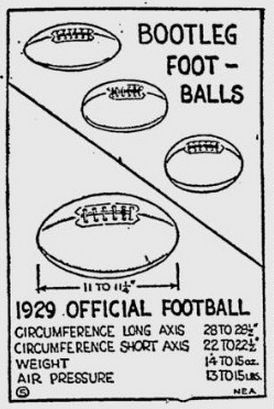 This sort of behavior was finally addressed by the college football Rules Committee – whose lead the NFL usually followed – in 1929. The year before, according to The New York Times, “reports began to come in that strangely shaped balls had been observed in play – balls with ‘snouts ideally adapted to gripping for forward passing’ – and that dealers were selling ‘either passing balls or kicking balls’ at the option of the buyer.
This sort of behavior was finally addressed by the college football Rules Committee – whose lead the NFL usually followed – in 1929. The year before, according to The New York Times, “reports began to come in that strangely shaped balls had been observed in play – balls with ‘snouts ideally adapted to gripping for forward passing’ – and that dealers were selling ‘either passing balls or kicking balls’ at the option of the buyer.
Reports also were received of overinflation of the football, the oval in some instances being blown up to 50 pounds of pressure, or more than three times the correct poundage, with a consequence that booting the ball felt like kicking a radiator or a hat with a brick in it. A punter capable of getting 40 yards with the genuine article thus could get no more than 27 or 28 yards with the rock-like counterfeit.
Blowing up the ball by guesswork at the corner garage, [committee chairman Edward K. Hall] said, naturally caused wide variation in the amount of inflation, and this, as well as the strange case of the snouted ball, his committee has already undertaken to remedy.
Under the rules for 1929 the use of a new apparatus designed to measure a football in length and width, after the manner of the foot-size gauge in shoe stores, will become compulsory. The referee before the game will slip the ball into this box-like contrivance and determine in an instant when a football is not a football within the meaning of the committee.
After that, you heard hardly a peep about footballs not meeting specifications. As long as the balls were, well, in the ballpark size-wise, everything was copacetic. And remember, for decades the home team furnished the balls — and inflated them to suit their own quarterback, not the visitors’. Baugh told me the Steelers liked to use a ball made by Goldsmith that had “10 laces instead of eight, and it was just fatter than everything. . . . You could throw it, but it was a different kind of ball.”
And now, all these years later, we have one of the greatest quarterbacks of all time getting suspended for a quarter of the season for the Deflategate fiasco. It just doesn’t seem possible. For this, Tom Brady is going to be branded with a scarlet D?
But then, these are different times from the ’20s and ’70s, more judgmental in some respects. (Or maybe it’s just that social media can turn any molehill into a mountain in the space of 140 characters.) We also, let’s not forget, have a commissioner who’d been under fire for his laxness in dealing with disciplinary cases — and who may very well have overreacted to Deflategate to make up for his initial underreaction to Ray Rice’s Frazieresque left hook.
Those who rooted for Goodell to make an example of Brady and his “outlaw” team love to talk about The Integrity of the Game. Sorry, everybody, but that horse left the barn long ago — if, indeed, it was ever in the barn. Respect for the rules in the NFL has always been grudging. Coaches and players are forever trying to bend them, twist them and circumvent them in ways totally contrary to the spirit of said rules.
That’s sports for you. Find a loophole, create a (temporary) edge. Some call it cheating, others gamesmanship. In truth, it’s probably a little of both, but the point is: It’s engrained — and you’re dreaming if you think much can be done about it.
The question then becomes: What “crimes” are you going to punish? Or, more to the point, are you going to punish a quarterback for conspiring to shrink the size of the ball, almost imperceptibly, so he feels more confident throwing it? I say “feels more confident throwing it” because it’s not certain Brady enjoyed any real competitive advantage. As Peter King pointed out the other day, there’s little difference in the last nine seasons between Tom’s passer rating in home games (100.2) vs. road games (99.7). And in road games, obviously, he doesn’t have the Patriots’ ballboys with him.
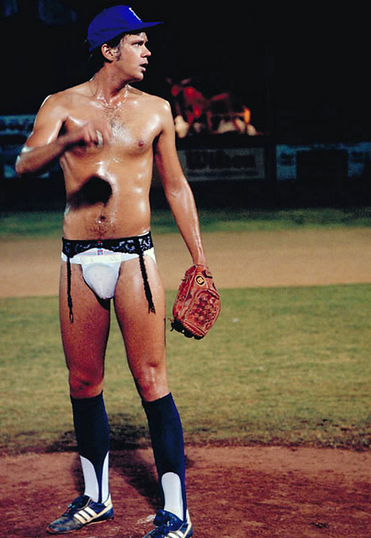
Are Tom Brady’s deflated footballs like Nuke LaLoosh’s garter belt?
It may well be that Brady prefers a softer ball because he’s always thrown a softer ball, all the way back to his days at Michigan. In other words, the effect might be more psychological than measurable — like Nuke LaLoosh pitching better in Bull Durham when he wears a garter belt. Fully inflated balls certainly didn’t take away from Tom’s performance in the second half of the AFC championship game (12 of 14 for 131 yards and two touchdowns) . . . or in the Super Bowl (37 of 50 for 328 and four scores). In those six quarters he had a rating of 114.
Here’s what defies logic: The NFL has spent the last 80-odd years catering to quarterbacks by (a.) slimming down the ball (most recently in 1988), (b.) adjusting the rules to open up the passing game and (c.) making it easier, generally, to play the position (see: intentional grounding). It’s also getting harder and harder to hit the passer without drawing a flag. He’s got a “strike zone” these days the size of Eddie Gaedel’s.
In 2006 Brady and Peyton Manning mobilized quarterbacks and convinced the league to let them decide which balls would be used in games. This enabled them to practice with the balls during the week and have them prepared to their individual liking — rougher, smoother, more inflated, less inflated, etc. As a result, passing stats have exploded, scoring is at record highs and profits, naturally, keep going up and up.
After all this coddling of quarterbacks, the NFL is putting its foot down now? Now it’s saying, “This is going too far. Ball pressure can’t fall below 12 ½ pounds”?
Why on earth not? Does football cease being football under those conditions? Does the ball become so squeezable that fumbles, an increasingly endangered species, become extinct? (By the way, it’s not like any of this impacts the kicking game, because kickers are now required to use straight-from-the-factory K balls — a move brought about by widespread doctoring of the ball.
Which reminds me: Does anybody recall a kicker being suspended for four games, or any games, for sticking a ball in a microwave to “get it ready”? No? Wanna know why? Because once upon a time, the NFL had a sense of proportion. When an issue like this came up, it didn’t launch a four-month, multimillion-dollar investigation. It merely said, “We have to provide more supervision. Clearly, teams can’t be left to their own devices.” And the issue went away.
This whole Brady business is the silliest of stands for the league to take. It shouldn’t matter if the Patriots quarterback is partial to a slightly underinflated ball, just as it shouldn’t matter if Aaron Rodgers likes ’em overinflated. If it doesn’t change the game in some undesirable way, why would anyone make a big deal of it.
Unless, that is, he had an agenda, one that didn’t necessarily have anything to do with “protecting The Shield” . . . or whatever Goodell’s objective is.

